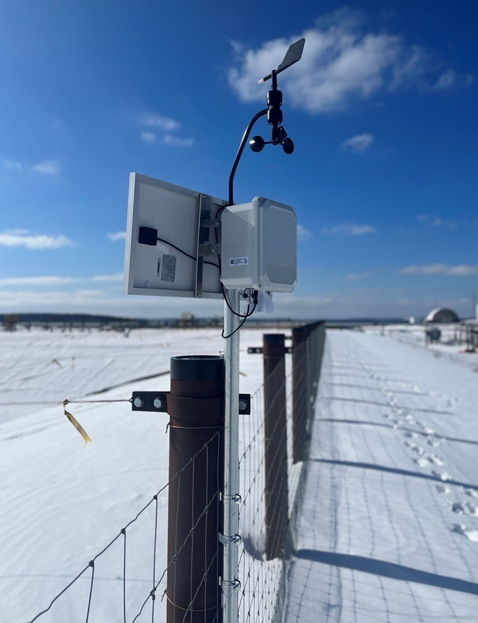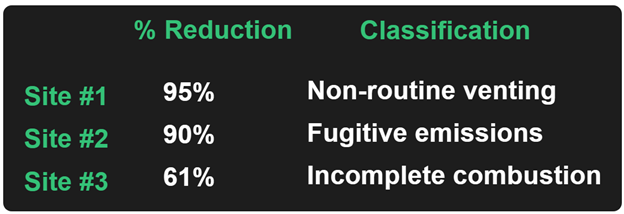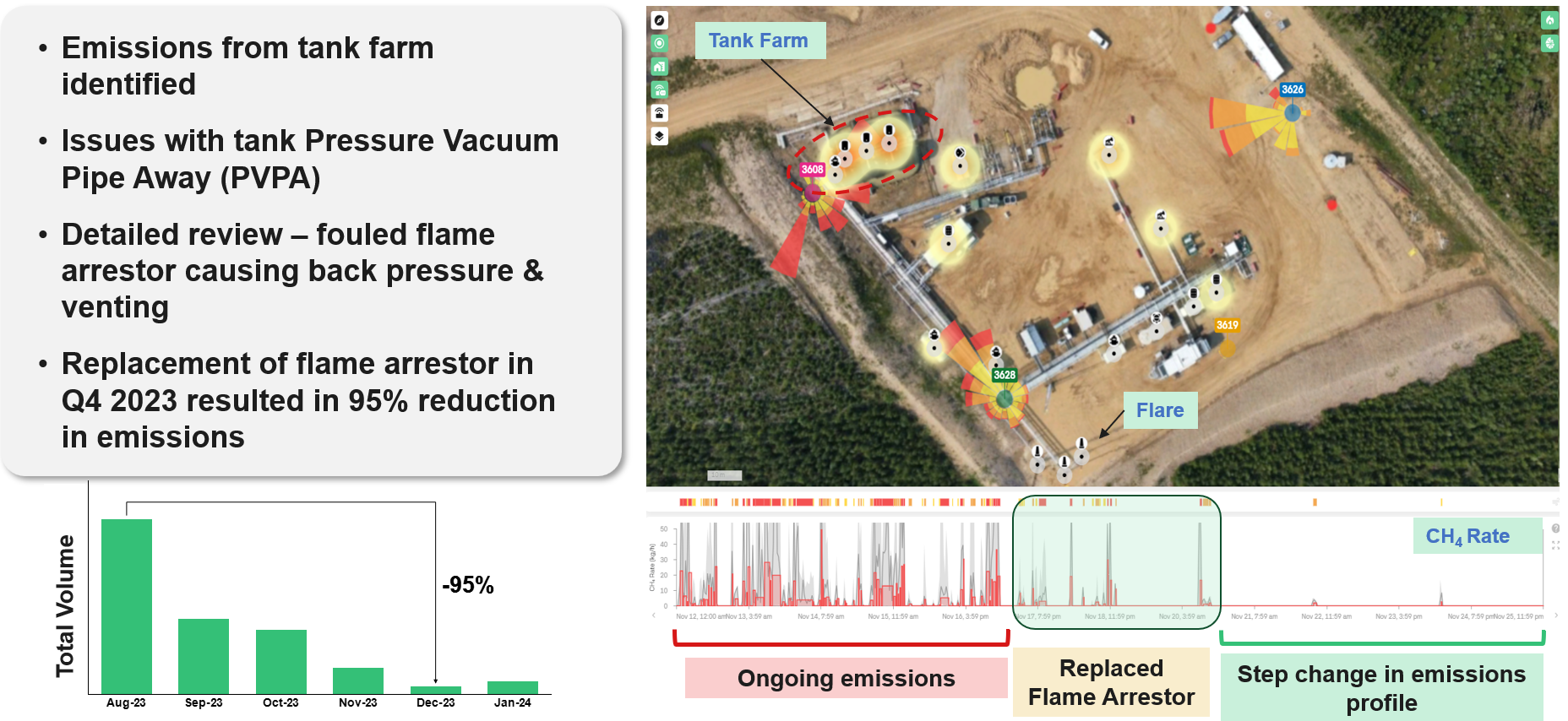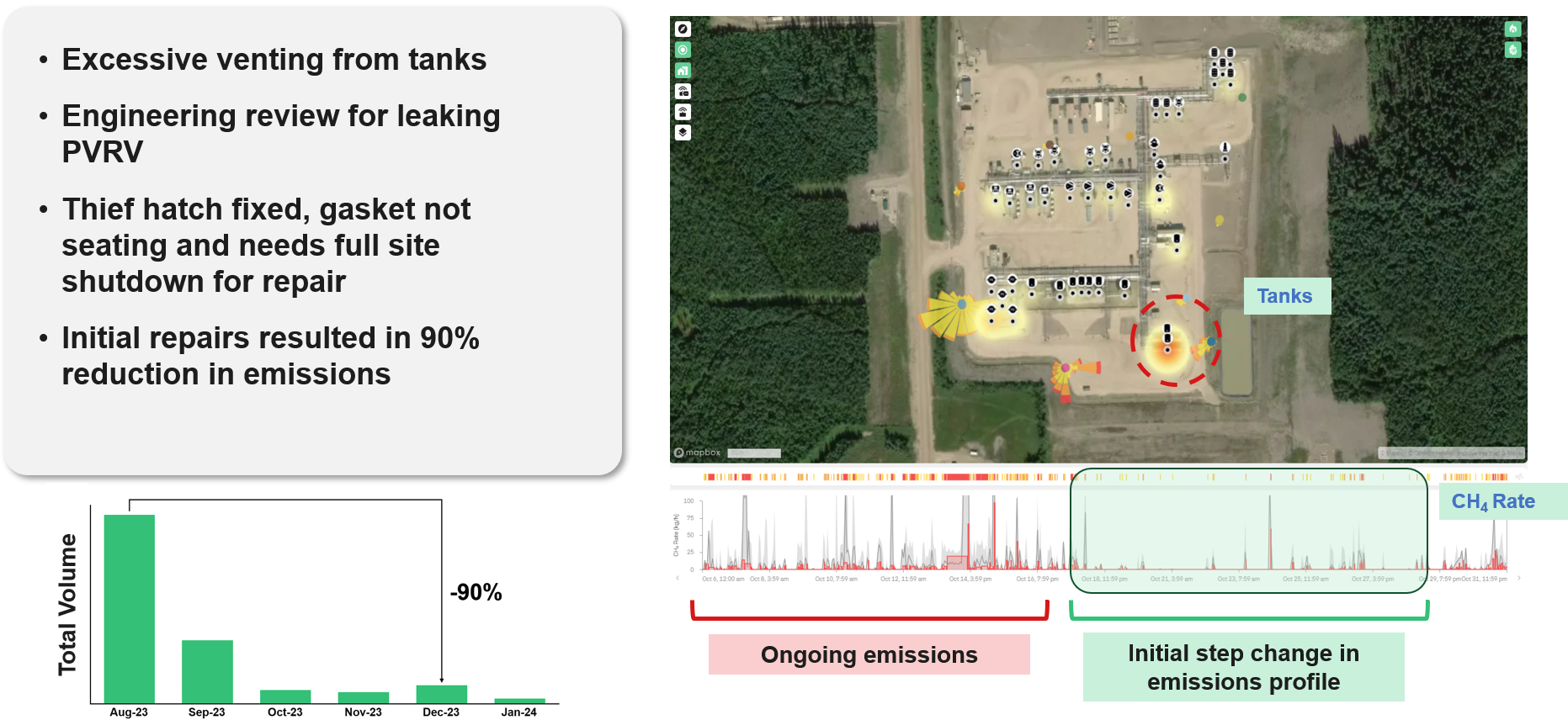Success Stories in Achieving Emissions Reductions Through Continuous Monitoring
The Modern Age of Continuous Monitoring
Environmental regulation and compliance is rapidly changing, and with it, many significant advancements in emission monitoring have occurred. These innovations have the potential to change the way industries monitor and reduce their emissions footprints, especially in real-time analysis through on-the-ground sensor arrays. At Qube, we are leading the innovation and integration of Continuous Monitoring (CM) technologies through the Qube Platform and our own Axon devices. Below we’ll share success stories from our work with a customer and the Alberta Alternative Fugitive Emission Management Program* (Alt-FEMP). We’ll also share three more success stories achieved in short periods of time through CM technology.
Continuous Monitoring Technologies: The Future in Emission Detection
Figure 1: Axon device field deployment
Continuous monitoring technologies, like those developed by Qube, represent a significant shift from traditional periodic monitoring methods like Optical Gas Imaging (OGI). Leveraging the Industrial Internet of Things (IIoT), our systems provide real-time data and notifications on emissions, allowing for immediate response that significantly reduces the time between detection and repair. Qube, in collaboration with multiple customers, has successfully deployed CM through the Alt-FEMP program by utilizing continuous monitoring to analyze emissions across multiple organizations and sites.
Regulatory Changes and New Monitoring Capabilities
The recent changes in regulatory frameworks to include these advanced technologies is crucial for their widespread adoption. Alberta Energy Regulator's Directive 060 and Alt-FEMP are examples of how regulations are evolving. These programs allow for the use of alternative technologies under pilot or full-scale implementations to meet or exceed traditional monitoring requirements. By incorporating continuous monitoring solutions, regulators are acknowledging the benefits of real-time data and its impact on management of environmental risks.
Alt-FEMP Case Study: Enhancing Emission Management
Through the Alt-FEMP initiative, Qube and “Customer A” in Alberta have deployed ~200 continuous monitoring devices, achieving a 55% cut in emissions at ~50 sites in just four months. This pilot provided immediate alerts on methane leaks, directly leading to a significant reduction of over 50 tonnes of emissions (includes 46 tonnes of methane or about 1,371 Mt CO2e – See IPCC AR6 for GWP factors). The practical application of continuous monitoring has demonstrated clear benefits in swiftly addressing emissions. The pilot showed a substantial reduction in response times to emission detection events and improved the overall repair programs. Additionally, the data collected has been important in Customer A’s improvements of operations data analysis, which is essential for decreasing resource load and field response of emission mitigation efforts.
Figure 2: Alt-FEMP initiative results with ~200 continuous monitoring devices from Qube
CM Emission Reduction Success Stories
Figure 3: Reduction Success Stories
The integration of continuous monitoring technologies has real improvements for industry practices. The use of continuous monitoring not only helps in meeting regulatory requirements but also plays a crucial role in corporate sustainability efforts. As you’ll see below, the use of these technologies at multiple companies and operational sites has led to enhanced leak detection capabilities, thereby reducing the risk of financial penalties and improving overall environmental performance.
Site #1: Plugged Flame Arrestor
Background: At Site #1, a tank farm experienced emissions due to a plugged flame arrestor. This caused back pressure and venting issues that needed urgent attention to minimize emissions and comply with regulations.
Challenge: The primary challenge was identifying the source of these emissions and this became possible with Qube’s CM devices. The tank's Pressure Vacuum Pipe Away (PVPA) was identified as the source with settings that were misaligned due to the fouling of the flame arrestor.
Solution: A detailed review and diagnostic process identified a fouled flame arrestor as the root cause. The arrestor was promptly replaced.
Outcome: The replacement of the flame arrestor led to a dramatic 95% reduction in emissions from the site. This result underscores the effectiveness of targeted maintenance and the potential environmental benefits of timely interventions.
Figure 4: Plugged Flame Arrestor
Site #2: Fugitive Emissions from Leaking PVRV
Background: This site faced challenges with excessive venting from tank storage. Qube identified the root source as a leaking Pressure Vacuum Relief Valve (PVRV). The leakage was significant enough to require a comprehensive engineering review.
Challenge: The main issue was a thief hatch that was not seating correctly, leading to continuous emissions. The site's design required a full shutdown for effective repairs, presenting logistical and operational challenges.
Solution: Initial repairs were swiftly carried out to minimize emissions, and a full site shutdown was planned for a comprehensive solution to align with other maintenance activities.
Outcome: The initial steps taken to fix the leaking PVRV resulted in a 90% reduction in emissions. This case highlights the importance of rapid response capabilities and the effectiveness of engineering solutions in emission control.
Figure 5: Fugitive Emissions from Leaking PVRV
Site #3: Incomplete Combustion Issues
Background: Elevated emissions and CO concentrations were detected at this site, primarily due to fuel gas slippage from compressors.
Challenge: The challenge was diagnosing the specific cause of the high emissions. Initial analysis and Qube sensors indicated incomplete combustion as a probable cause, requiring further detailed investigation.
Solution: Exhaust sampling was conducted, which confirmed the initial diagnosis. Adjustments and tuning of the fuel system were implemented to optimize combustion efficiency.
Outcome: These adjustments resulted in a 61% reduction in emissions at the site, demonstrating the critical role of precise diagnostics and tailored technical interventions in managing and reducing emissions.
Figure 6: Incomplete Combustion Issues
The Future of Advanced Monitoring Technologies
Environmental compliance and emissions management is being reshaped by continuous monitoring technologies. As regulatory bodies continue to adapt and integrate these technologies into their frameworks, we can expect significant improvements in the industry's ability to manage and mitigate environmental impact. This transition not only supports regulatory compliance but also aligns with broader sustainability goals, marking the shift towards lower emissions, lower costs and increased sustainability.
*Footnote:
The Alternative Fugitive Emission Management Program (Alt-FEMP) is a regulatory framework implemented by the Alberta Energy Regulator (AER) to accommodate and encourage innovative approaches to monitoring and managing fugitive emissions in the oil and gas industry. This program is especially relevant as it recognizes and allows for the adoption of new technologies and methods that differ from traditional monitoring techniques, such as Optical Gas Imaging (OGI). Here’s a summary of what the Alt-FEMP entails and its approval process:
Objectives of Alt-FEMP
Innovation Encouragement: Alt-FEMP is designed to foster innovation by allowing companies to implement alternative technologies and practices for detecting and quantifying fugitive emissions.
Regulatory Flexibility: It provides flexibility in regulatory compliance, enabling operators to use methods that may be more effective or suitable for their specific operations compared to traditional methods.
Enhanced Environmental Protection: By integrating advanced technologies, Alt-FEMP aims to improve the detection and repair of leaks, thereby reducing emissions more effectively and supporting environmental protection goals.
Components of the Alt-FEMP
Technology Integration: Operators can use alternative technologies such as drones, aircraft, continuous monitoring devices, and satellite imagery to detect fugitive emissions.
Pilot and Full-Scale Programs: Companies can apply for either pilot or full-scale programs under Alt-FEMP. Pilot programs allow for the testing and validation of new technologies on a smaller scale before full implementation.
Performance Reporting: Participants must submit performance reports to AER, detailing the effectiveness of the technology used, the volume of emissions reduced, and any challenges encountered.
Approval Process
Application Submission: Operators submit an application to AER, outlining the technology or method they plan to use, the scope of its application, and the expected outcomes.
Review and Assessment: AER reviews the application to ensure that the proposed methods meet or exceed the effectiveness of conventional monitoring technologies in identifying and reducing emissions.
Approval and Implementation: If approved, operators implement the alternative methods as part of their fugitive emissions management program.
Monitoring and Compliance: Throughout the implementation, operators monitor the effectiveness of the technology and adhere to compliance requirements set by AER.
Reporting and Evaluation: At the end of the approved period, operators must submit a detailed report evaluating the technology’s performance, which AER uses to determine the success of the alternative approach and decide on any further applications.
Impact and Benefits
Operational Efficiency: Alt-FEMP can lead to more efficient operations by reducing the time and resources needed for emissions monitoring and repair.
Emissions Reduction: Effective implementation of alternative technologies can significantly reduce fugitive emissions, contributing to Alberta’s overall environmental targets.
Innovation and Industry Leadership: Encouraging the use of cutting-edge technologies positions Alberta’s oil and gas industry as a leader in environmental stewardship and technological innovation.
Alt-FEMP is a critical part of Alberta's regulatory strategy to reduce greenhouse gas emissions, offering a pathway for industries to contribute to environmental goals through innovative technologies and practices.






